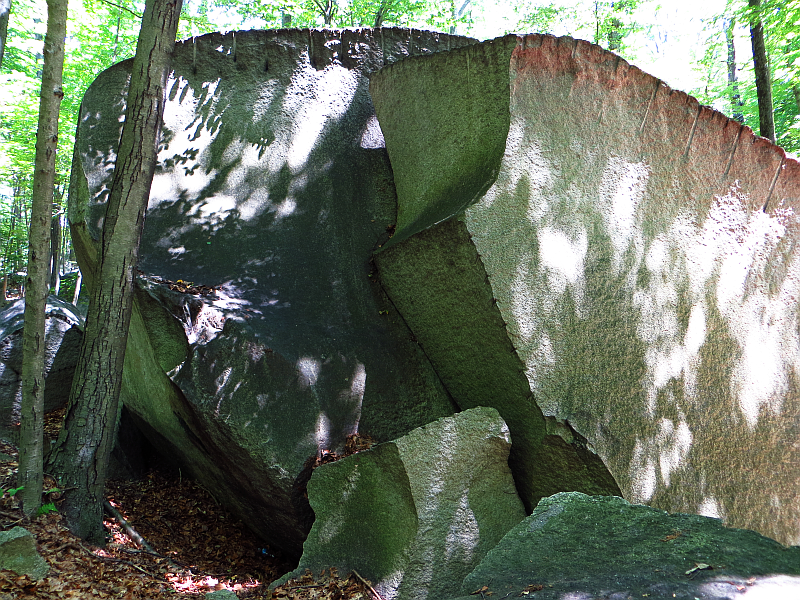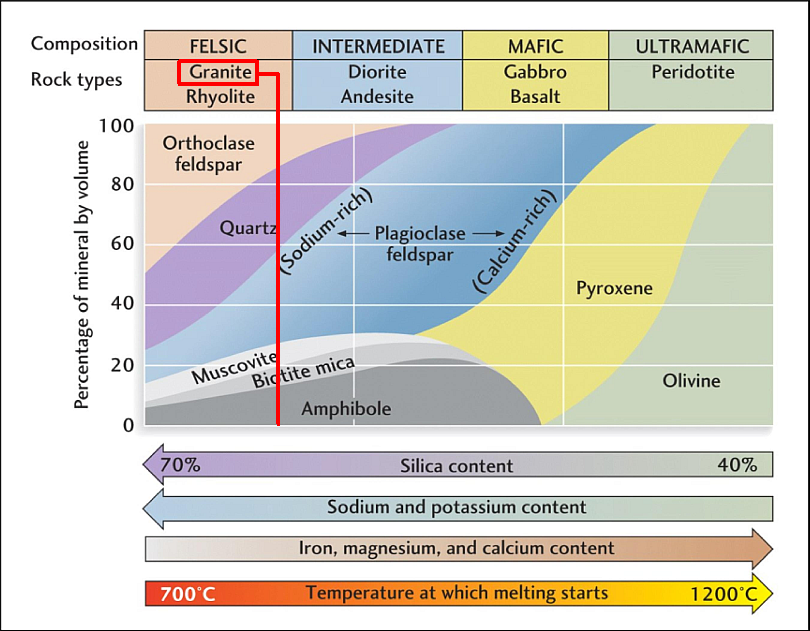Granite Knolls EarthCache
-
Difficulty:
-

-
Terrain:
-

Size:  (other)
(other)
Please note Use of geocaching.com services is subject to the terms and conditions
in our disclaimer.
Welcome to Granite Knolls Park in Yorktown Heights.
You can probably guess what kind of rock this Earthcache is about...
NYNJTC offers a free trail map for Granite Knolls and for Legacy Field that might be of help so that you don't get lost while finding rocks...

Classification of Granite (bear with me, it won't hurt much :)
- Granite is an igneous rock, which means that it is of volcanic origin.
Granite is NOT a sedimentary rock (like Sandstone) and also not a metamorphic rock (like Gneiss)
- Granite is an intrusive igneous rock, which means that its hot molten material solidified deep in the earth. Slow cooling is needed to give the typical crystals in Granite the time to form and grow.
Granite is NOT an extrusive igneous rock (like Basalt or Rhyolite). Extrusive rocks are formed from lava that breaks through to the surface, and therefore cools way more rapidly. The crystals in extrusive rocks are therefore much smaller, because they had less time to form.
- Granite is a felsic rock, which means that it is high in silica, usually in the form of Quartz and Feldspar. FelSic stands for Feldspar-Silica.
Granite is NOT a mafic rock (like Basalt or Gabbro) which are rich in metals like iron and magnesium. MaFic stands for Magnesium-Ferric (ferron = iron).
There we go. Wasn't all that bad, or was it? You now know some of the key characteristics along which geologists classify rocks, and in particular rocks of volcanic origin. They look for the size of crystals, which tells them if the rock is intrusive or extrusive. Then they look for the composition, primarily the presence of quartz and feldspar, which tells them if the rock is felsic or mafic. The chart below, taken from "Understanding Earth, 5th Edition", nicely sums this up.

The "red line" through the chart shows which composition of a rock causes it to be called "Granite": We can expect Quartz (greyish-translucent), two kinds of Feldspar (pink or white), and some presence of Mica (the shiny flaky stuff - both Muscovite and Biotite) and Amphibole (the dark spots).
Two kinds of Feldspar? Yes. This is where things get a bit messy. Feldspar comes in a kalium-(K)-rich form, called Orthoclase Feldspar, and in a Sodium-(Na)- or Calcium-(Ca)-rich form that is called Plagioclase Feldspar. Don't despair, even rock geeks have to take Granite and Feldspar samples back to the lab to tell with certainty which is which. In the case at hand, my non-professional guess is that we are dealing with Granite rich in Plagioclase Feldspar, and the amount of Plagioclase (and lack of Orthoclase) present even pushes us into the "Diorite" column of the chart above. This bit isn't all that important for you to solve this Earthcache, so never mind. [But if you are an expert, I'd love to know for sure!]
In order to claim a find on this Earthcache, please email me the answers to the following questions. You don't have to wait for my reply, go ahead and log the cache, I will contact you if something in your answers is way off.
- Go to the pedestrian bridge over the Taconic (initial waypoint), and look at the stone that clads the top of the railing. What type of rock do you think this is? Why?
Before you leave the bridge, you might want to take a picture of the rock, to make comparison easier in question #5. Then, continue to the second waypoint, which is an old Granite Quarry. Take your time to explore, this is a pretty cool spot, and one of the largest boulders in New York State. Along the edge of the huge boulder, there is ample evidence of quarrying, and if you climb to the top of the rock (be careful) you can also see the names that some of the old masons carved into the boulder. Old fashioned Quarrying is pretty neat, check out Youtube to see how this was done!
- What is the approximate width (thickness) of the most recent slab/slice that was split off the main boulder?
- Do you think the slab was split off with wedges, or by blasting? Why?
In front of the boulder is a pile of large blocks that were split in the quarrying, but not carted off. Find one with a nice vertical surface that is not as exposed to the elements and weathering as the rock tops are, and study the composition of the Granite.
- Does it have more black or more white crystals? What kind of mineral do you think the white parts are?
- How does this rock differ from the one that you saw at the bridge?
You are welcome to post pictures with your log, but kindly don't post any that give away the answers (eg. no close-up of the bridge cladstone or boulder rock type please. Thanks!)
Materials used:
Understanding Earth, 5th Edition, Grotzinger Jordan Press Siever, ISBN 0-7167-6682-5
10^9 Years, A Guide to the Geology of Westchester County, Thomas McGuire (out of print)
Cortlandt Igneous Complex, Charles Merguerian, Hofstra University Field Trip Notes, 2008
Additional Hints
(No hints available.)